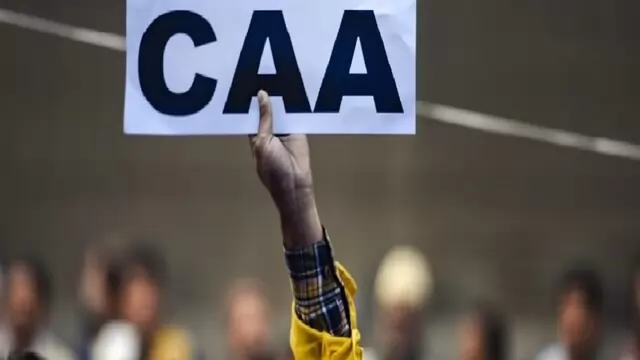Notification of the Central Government’s Rules for the 2019 Citizenship Amendment Act (CAA)
Syllabus : GS2/Government Policies and Interventions
Why in News
- The Ministry of Home Affairs recently notified the Citizenship Amendment Rules (CAA Rules) for March 2024. This prepares the door for the implementation for the CAA, which was enacted by parliament in December 2019.
Background
- The CAA expedites the process to citizenship for persecuted minorities from Pakistan, Afghanistan, and Bangladesh, including Hindus, Sikhs, Buddhists, Jains, Parsis, and Christians who entered India before December 31, 2014. The CAA Rules specify the application process and eligibility criteria for some migrants seeking Indian citizenship.

India’s 2019 Citizenship Amendment Act (CAA).
- Citizenship Amendment Act (CAA), 2019: Under certain situations, this act alters the Citizenship Act, 1955 to expedite the acquisition of citizenship for immigrants from Afghanistan, Bangladesh, and Pakistan who belong to religious groups that include Hindu, Sikh, Buddhist, Jain, Parsi, and Christian.
- Nationwide demonstrations: Due to worries about citizenship being awarded based only on religion and the possible effects on regional demography, the CAA encountered resistance and demonstrations throughout India, especially in Assam.
- Delayed implementation: The government had to create regulations before the act could be put into effect, which resulted in a delay. The CAA could not be put into effect right away since these regulations were missing.
- Order under Section 16: In accordance with Section 16 of the Citizenship Act of 1955, the national government issued an order on May 28, 2021. This gave district collectors in thirteen districts with significant immigrant populations the authority to accept citizenship petitions from the CAA-listed groups.
Citizenship Amendment Act (CAA), 2019
- Hindus, Sikhs, Buddhists, Jains, Parsis, and Christians—apart from Muslims—who fled Pakistan, Afghanistan, and Bangladesh because of religious persecution are to have their Indian citizenship expedited under the CAA, 2019.
- The 2019 modification essentially loosened the requirements for some groups of migrants from three nearby Muslim-majority nations in terms of their eligibility (based on religious affiliation).
Exclusivity
- The CAA did not apply to several places; these included territories protected by the “Inner Line” system and tribal areas in Assam, Meghalaya, Mizoram, and Tripura.
- The idea of the Inner Line divides the lowland regions of the Northeast from the hills inhabited primarily by tribal people. To enter and remain in these regions, you need an Inner Line Permit (ILP).
Highlights of the Citizenship (Amendment) Rules, 2024
Eligibility: Who can apply for Citizenship
- Individuals of Indian origin seeking registration as Indian citizens.
- Individuals married to Indian citizens, seeking registration as Indian citizens.
- Minor children of Indian citizens applying for registration as Indian citizens, etc.
Documents Required for Citizenship by Naturalization
- Submission of Form VIIIA: The applicant files Form VIIIA, which contains all the personal data and information needed to complete the naturalization procedure.
- Affidavit Verification: In order to confirm the veracity of the statements included in the application, the applicant must provide an affidavit.
- Character Affidavit: In addition, the applicant needs to provide an Indian citizen’s affidavit attesting to their character. This affidavit serves as confirmation of the applicant’s moral character and repute.
- Language Declaration: The applicant must certify that they are sufficiently conversant in one of the languages listed in the Eighth Schedule to the Indian Constitution.
Process for Application Submission
- Application Submission: Applicants must electronically submit their applications to the Empowered Committee via the Central Government-designated District Level Committee.
- Acknowledgment: An electronic Form IX acknowledgment is generated upon submission.
- Document Verification: The documents that are presented with the application are verified by the District Level Committee, which is chaired by a Designated Officer.
- Taking the Oath of Allegiance: The applicant is given the oath of allegiance outlined in the Second Schedule to the Citizenship Act, 1955 by the Designated Officer.
- Renunciation Declaration: Each application contains a statement from the applicant stating that they hereby unconditionally and irrevocably renounce their citizenship in the nation in which they now reside.
Issues/Challenges
- Legal Challenge: The Indian Union Muslim League (IUML) and others filed a legal challenge against the 2019 amendment before the Supreme Court in 2020, claiming discrimination.
- Article 14 of the Constitution ensures “equality before the law or the equal protection of the laws within the territory of India.” This is the basis for the challenge against the CAA, arguing that it breaches the right to equality. The petitioners contend that it is unconstitutional to use religion as a criterion for discrimination.
- Targeted Towards Muslims: The petitioners contend that Muslims will be singled out by the CAA and the National Register of Citizens (NRC) in Assam, which are both used to track out illegal immigrants.
- Secularism: It is debatable if requiring citizenship to be granted based on one’s religious beliefs goes against the fundamental tenet of the Constitution, which is secularism.
- Assam Accord (1985): This agreement between the Indian government and the All-Assam Students’ Union (AASU) set March 24, 1971, as the cut-off date for citizenship in Assam. This means that anyone who visited Assam before that date qualifies for Indian citizenship.
- Citizenship Amendment Act (CAA) 2019, This act grants citizenship to immigrants from certain religious minorities (excluding Muslims) who entered India before December 31, 2014, from Pakistan, Afghanistan, and Bangladesh. This defies the Assam Accord’s cut-off date, raising concerns in Assam about future migration.

No Comments